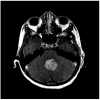Medulloblastoma
- PMID: 26336203
- PMCID: PMC4995146
- DOI: 10.1177/0883073815600866
Medulloblastoma
Erratum in
-
Corrigendum.J Child Neurol. 2016 Sep 15:0883073816670445. doi: 10.1177/0883073816670445. Online ahead of print. J Child Neurol. 2016. PMID: 27638311 No abstract available.
Abstract
Medulloblastoma accounts for nearly 10% of all childhood brain tumors. These tumors occur exclusively in the posterior fossa and have the potential for leptomeningeal spread. Treatment includes a combination of surgery, radiation therapy (in patients >3 years old). Patients >3 years old are stratified based on the volume of postoperative residual tumor and the presence or absence of metastases into "standard risk" and "high risk" categories with long-term survival rates of approximately 85% and 70%, respectively. Outcomes are inferior in infants and children younger than 3 years with exception of those patients with the medulloblastoma with extensive nodularity histologic subtype. Treatment for medulloblastoma is associated with significant morbidity, especially in the youngest patients. Recent molecular subclassification of medulloblastoma has potential prognostic and therapeutic implications. Future incorporation of molecular subgroups into treatment protocols will hopefully improve both survival outcomes and posttreatment quality of life.
Keywords: chemotherapy; embryonal tumor; medulloblastoma; pediatric brain tumor; posterior fossa mass.
© The Author(s) 2016.
Figures




References
-
- Bailey P, Cushing H. Medulloblastoma cerebelli: a common type of midcerebellar glioma of childhood. Arch Neurol Psychiatry. 1925;14(2):192–224.
-
- Kunschner LJ. Harvey Cushing and medulloblastoma. Arch Neurol. 2002;59(4):642–5. - PubMed
-
- Globus JH, Strauss I. Spongioblastoma multiforme: a primary malignant form of brain neoplasm: its clinical and anatomic features. Arch Neurol Psychiatry. 1925;14(2):139–191.
-
- Paterson E, Farr RF. Cerebellar medulloblastoma: treatment by irradiation of the whole central nervous system. Acta radiol. 1953;39(4):323–36. - PubMed
-
- Rutka JT, Hoffman HJ. Medulloblastoma: a historical perspective and overview. J Neurooncol. 1996;29(1):1–7. - PubMed
Publication types
MeSH terms
Grants and funding
LinkOut - more resources
Full Text Sources
Other Literature Sources
Medical

